Dissertation: Factors Affecting IPO Performance and Valuation Models
VerifiedAdded on 2023/03/24
|29
|11068
|65
Thesis and Dissertation
AI Summary
This dissertation explores the factors influencing Initial Public Offering (IPO) valuation and performance, focusing on the impact of underwriter reputation and the effectiveness of different valuation models, particularly the Price-to-Earnings (PE) ratio method. It investigates the influence of hot and cold market conditions on IPO returns, referencing previous research that highlights the significant differences in returns between these market periods. The study also examines the underwriter reputation hypothesis and its effect on underpricing. The research employs both quantitative analysis, using secondary data to compute PE ratios and compare firm and industry valuations, and qualitative analysis, incorporating expert interviews to assess the success of IPOs in different market conditions. The dissertation aims to provide insights for academics, business firms, and investors, especially those in Hong Kong, regarding the optimal timing and strategies for launching successful IPOs. Desklib provides access to similar dissertations and study resources.
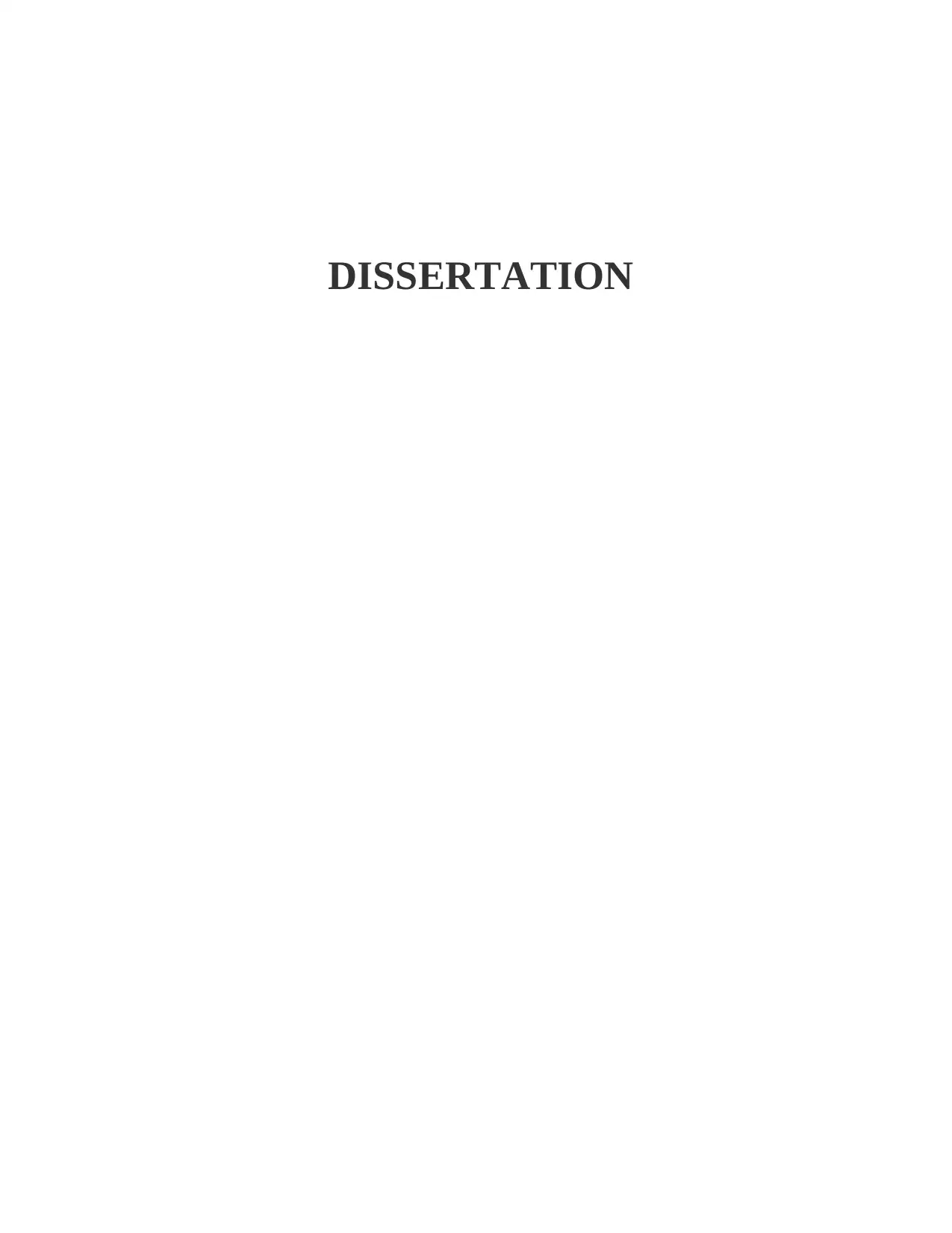
DISSERTATION
Paraphrase This Document
Need a fresh take? Get an instant paraphrase of this document with our AI Paraphraser
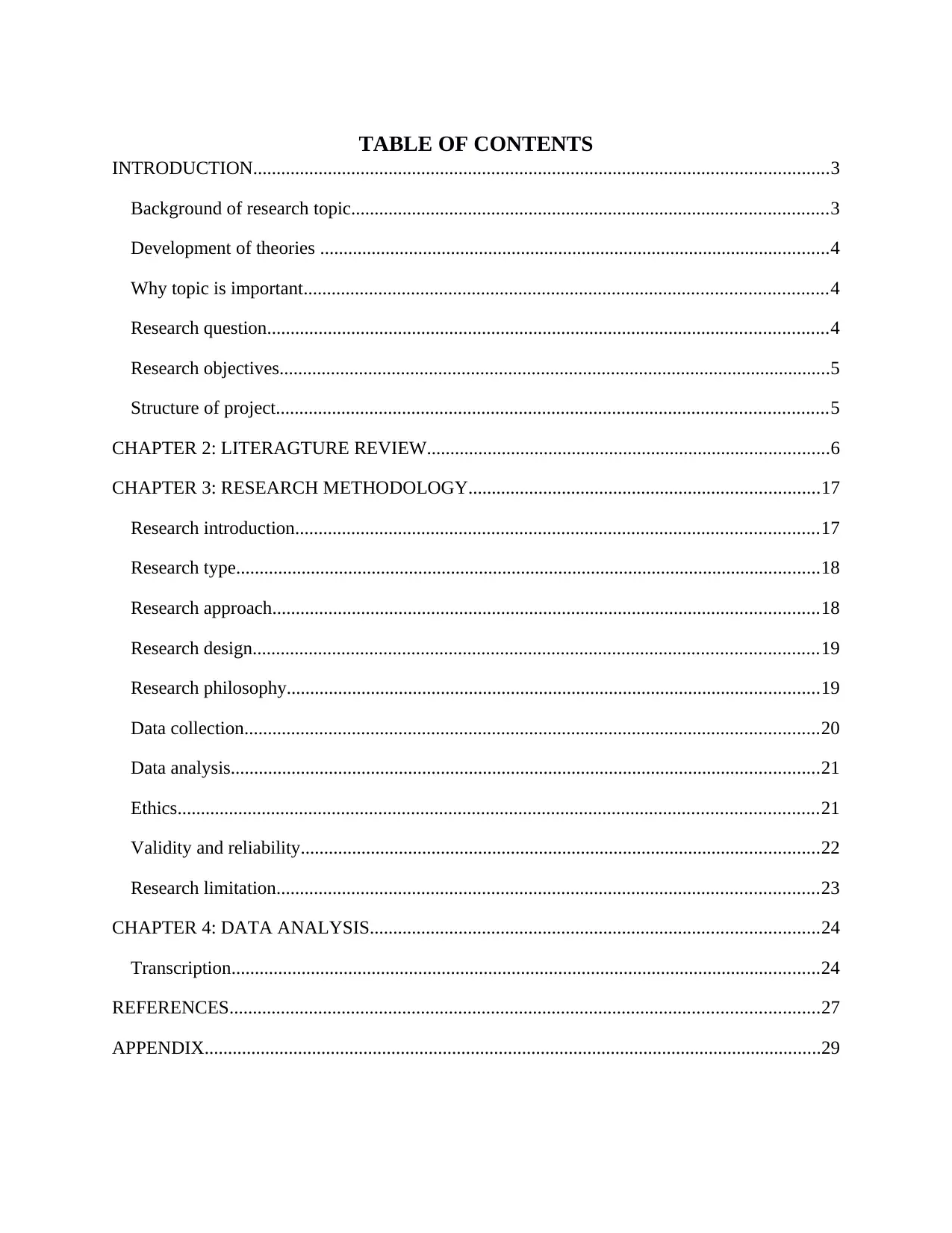
TABLE OF CONTENTS
INTRODUCTION...........................................................................................................................3
Background of research topic......................................................................................................3
Development of theories .............................................................................................................4
Why topic is important................................................................................................................4
Research question........................................................................................................................4
Research objectives......................................................................................................................5
Structure of project......................................................................................................................5
CHAPTER 2: LITERAGTURE REVIEW......................................................................................6
CHAPTER 3: RESEARCH METHODOLOGY...........................................................................17
Research introduction................................................................................................................17
Research type.............................................................................................................................18
Research approach.....................................................................................................................18
Research design.........................................................................................................................19
Research philosophy..................................................................................................................19
Data collection...........................................................................................................................20
Data analysis..............................................................................................................................21
Ethics.........................................................................................................................................21
Validity and reliability...............................................................................................................22
Research limitation....................................................................................................................23
CHAPTER 4: DATA ANALYSIS................................................................................................24
Transcription..............................................................................................................................24
REFERENCES..............................................................................................................................27
APPENDIX....................................................................................................................................29
INTRODUCTION...........................................................................................................................3
Background of research topic......................................................................................................3
Development of theories .............................................................................................................4
Why topic is important................................................................................................................4
Research question........................................................................................................................4
Research objectives......................................................................................................................5
Structure of project......................................................................................................................5
CHAPTER 2: LITERAGTURE REVIEW......................................................................................6
CHAPTER 3: RESEARCH METHODOLOGY...........................................................................17
Research introduction................................................................................................................17
Research type.............................................................................................................................18
Research approach.....................................................................................................................18
Research design.........................................................................................................................19
Research philosophy..................................................................................................................19
Data collection...........................................................................................................................20
Data analysis..............................................................................................................................21
Ethics.........................................................................................................................................21
Validity and reliability...............................................................................................................22
Research limitation....................................................................................................................23
CHAPTER 4: DATA ANALYSIS................................................................................................24
Transcription..............................................................................................................................24
REFERENCES..............................................................................................................................27
APPENDIX....................................................................................................................................29
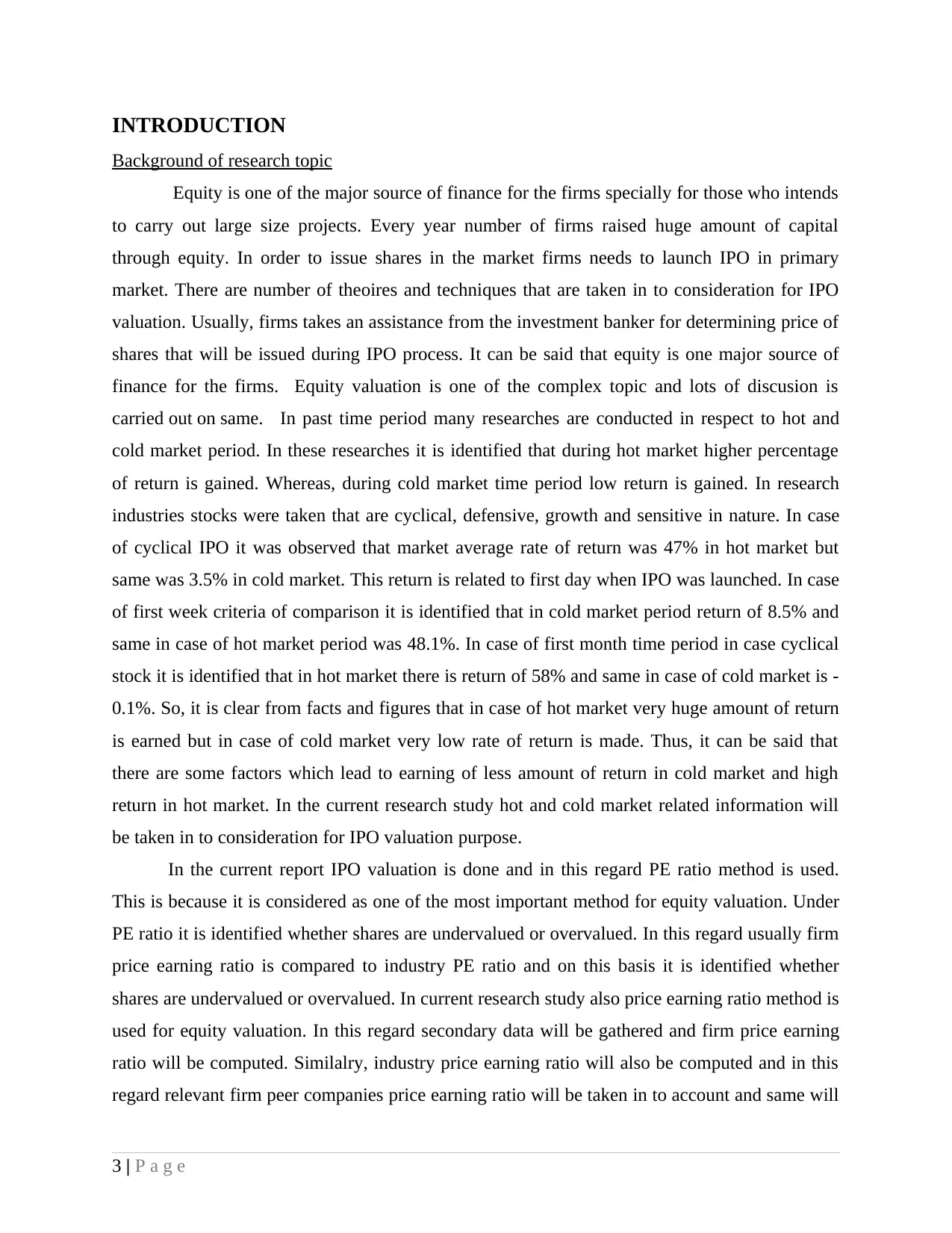
INTRODUCTION
Background of research topic
Equity is one of the major source of finance for the firms specially for those who intends
to carry out large size projects. Every year number of firms raised huge amount of capital
through equity. In order to issue shares in the market firms needs to launch IPO in primary
market. There are number of theoires and techniques that are taken in to consideration for IPO
valuation. Usually, firms takes an assistance from the investment banker for determining price of
shares that will be issued during IPO process. It can be said that equity is one major source of
finance for the firms. Equity valuation is one of the complex topic and lots of discusion is
carried out on same. In past time period many researches are conducted in respect to hot and
cold market period. In these researches it is identified that during hot market higher percentage
of return is gained. Whereas, during cold market time period low return is gained. In research
industries stocks were taken that are cyclical, defensive, growth and sensitive in nature. In case
of cyclical IPO it was observed that market average rate of return was 47% in hot market but
same was 3.5% in cold market. This return is related to first day when IPO was launched. In case
of first week criteria of comparison it is identified that in cold market period return of 8.5% and
same in case of hot market period was 48.1%. In case of first month time period in case cyclical
stock it is identified that in hot market there is return of 58% and same in case of cold market is -
0.1%. So, it is clear from facts and figures that in case of hot market very huge amount of return
is earned but in case of cold market very low rate of return is made. Thus, it can be said that
there are some factors which lead to earning of less amount of return in cold market and high
return in hot market. In the current research study hot and cold market related information will
be taken in to consideration for IPO valuation purpose.
In the current report IPO valuation is done and in this regard PE ratio method is used.
This is because it is considered as one of the most important method for equity valuation. Under
PE ratio it is identified whether shares are undervalued or overvalued. In this regard usually firm
price earning ratio is compared to industry PE ratio and on this basis it is identified whether
shares are undervalued or overvalued. In current research study also price earning ratio method is
used for equity valuation. In this regard secondary data will be gathered and firm price earning
ratio will be computed. Similalry, industry price earning ratio will also be computed and in this
regard relevant firm peer companies price earning ratio will be taken in to account and same will
3 | P a g e
Background of research topic
Equity is one of the major source of finance for the firms specially for those who intends
to carry out large size projects. Every year number of firms raised huge amount of capital
through equity. In order to issue shares in the market firms needs to launch IPO in primary
market. There are number of theoires and techniques that are taken in to consideration for IPO
valuation. Usually, firms takes an assistance from the investment banker for determining price of
shares that will be issued during IPO process. It can be said that equity is one major source of
finance for the firms. Equity valuation is one of the complex topic and lots of discusion is
carried out on same. In past time period many researches are conducted in respect to hot and
cold market period. In these researches it is identified that during hot market higher percentage
of return is gained. Whereas, during cold market time period low return is gained. In research
industries stocks were taken that are cyclical, defensive, growth and sensitive in nature. In case
of cyclical IPO it was observed that market average rate of return was 47% in hot market but
same was 3.5% in cold market. This return is related to first day when IPO was launched. In case
of first week criteria of comparison it is identified that in cold market period return of 8.5% and
same in case of hot market period was 48.1%. In case of first month time period in case cyclical
stock it is identified that in hot market there is return of 58% and same in case of cold market is -
0.1%. So, it is clear from facts and figures that in case of hot market very huge amount of return
is earned but in case of cold market very low rate of return is made. Thus, it can be said that
there are some factors which lead to earning of less amount of return in cold market and high
return in hot market. In the current research study hot and cold market related information will
be taken in to consideration for IPO valuation purpose.
In the current report IPO valuation is done and in this regard PE ratio method is used.
This is because it is considered as one of the most important method for equity valuation. Under
PE ratio it is identified whether shares are undervalued or overvalued. In this regard usually firm
price earning ratio is compared to industry PE ratio and on this basis it is identified whether
shares are undervalued or overvalued. In current research study also price earning ratio method is
used for equity valuation. In this regard secondary data will be gathered and firm price earning
ratio will be computed. Similalry, industry price earning ratio will also be computed and in this
regard relevant firm peer companies price earning ratio will be taken in to account and same will
3 | P a g e
⊘ This is a preview!⊘
Do you want full access?
Subscribe today to unlock all pages.

Trusted by 1+ million students worldwide
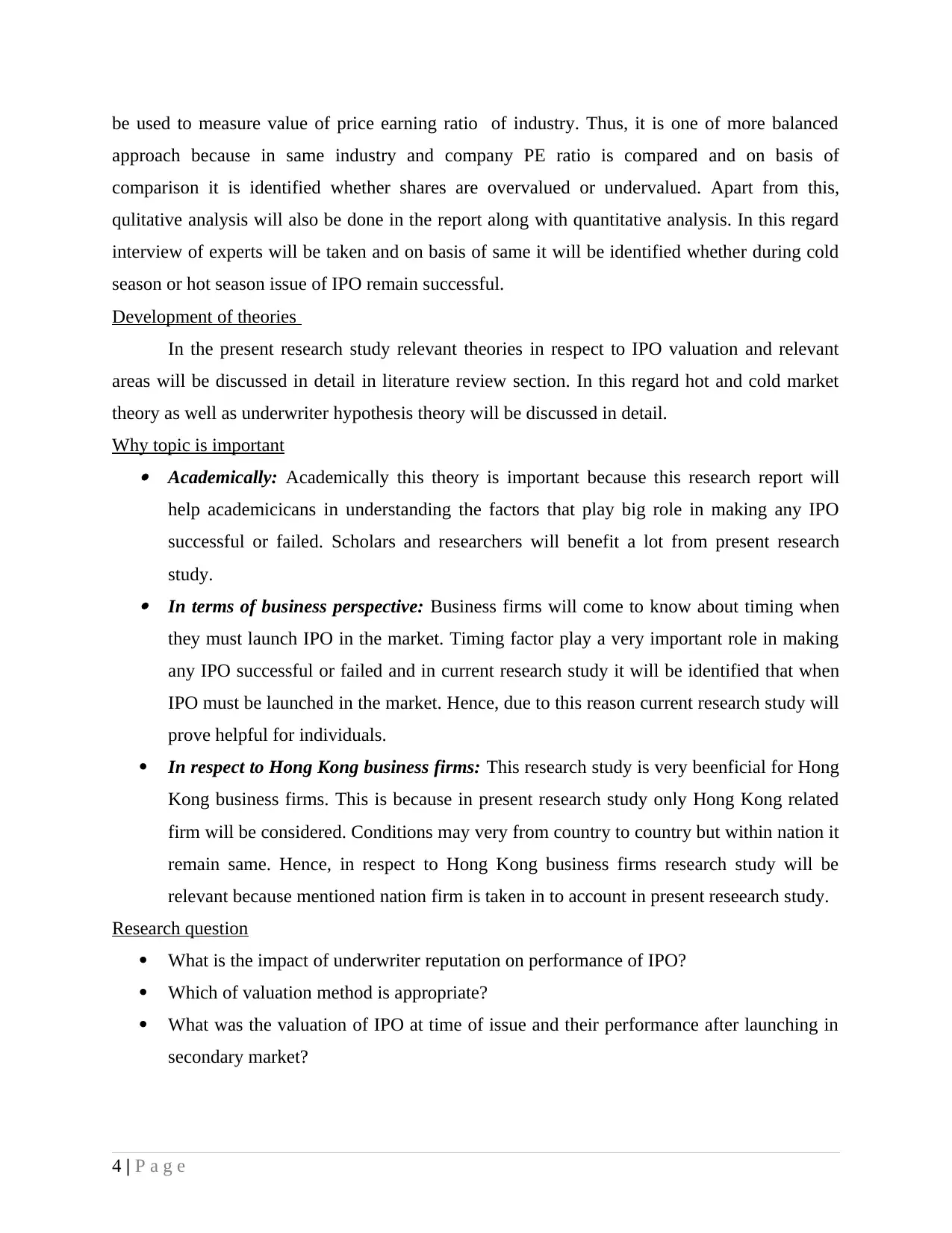
be used to measure value of price earning ratio of industry. Thus, it is one of more balanced
approach because in same industry and company PE ratio is compared and on basis of
comparison it is identified whether shares are overvalued or undervalued. Apart from this,
qulitative analysis will also be done in the report along with quantitative analysis. In this regard
interview of experts will be taken and on basis of same it will be identified whether during cold
season or hot season issue of IPO remain successful.
Development of theories
In the present research study relevant theories in respect to IPO valuation and relevant
areas will be discussed in detail in literature review section. In this regard hot and cold market
theory as well as underwriter hypothesis theory will be discussed in detail.
Why topic is important Academically: Academically this theory is important because this research report will
help academicicans in understanding the factors that play big role in making any IPO
successful or failed. Scholars and researchers will benefit a lot from present research
study. In terms of business perspective: Business firms will come to know about timing when
they must launch IPO in the market. Timing factor play a very important role in making
any IPO successful or failed and in current research study it will be identified that when
IPO must be launched in the market. Hence, due to this reason current research study will
prove helpful for individuals.
In respect to Hong Kong business firms: This research study is very beenficial for Hong
Kong business firms. This is because in present research study only Hong Kong related
firm will be considered. Conditions may very from country to country but within nation it
remain same. Hence, in respect to Hong Kong business firms research study will be
relevant because mentioned nation firm is taken in to account in present reseearch study.
Research question
What is the impact of underwriter reputation on performance of IPO?
Which of valuation method is appropriate?
What was the valuation of IPO at time of issue and their performance after launching in
secondary market?
4 | P a g e
approach because in same industry and company PE ratio is compared and on basis of
comparison it is identified whether shares are overvalued or undervalued. Apart from this,
qulitative analysis will also be done in the report along with quantitative analysis. In this regard
interview of experts will be taken and on basis of same it will be identified whether during cold
season or hot season issue of IPO remain successful.
Development of theories
In the present research study relevant theories in respect to IPO valuation and relevant
areas will be discussed in detail in literature review section. In this regard hot and cold market
theory as well as underwriter hypothesis theory will be discussed in detail.
Why topic is important Academically: Academically this theory is important because this research report will
help academicicans in understanding the factors that play big role in making any IPO
successful or failed. Scholars and researchers will benefit a lot from present research
study. In terms of business perspective: Business firms will come to know about timing when
they must launch IPO in the market. Timing factor play a very important role in making
any IPO successful or failed and in current research study it will be identified that when
IPO must be launched in the market. Hence, due to this reason current research study will
prove helpful for individuals.
In respect to Hong Kong business firms: This research study is very beenficial for Hong
Kong business firms. This is because in present research study only Hong Kong related
firm will be considered. Conditions may very from country to country but within nation it
remain same. Hence, in respect to Hong Kong business firms research study will be
relevant because mentioned nation firm is taken in to account in present reseearch study.
Research question
What is the impact of underwriter reputation on performance of IPO?
Which of valuation method is appropriate?
What was the valuation of IPO at time of issue and their performance after launching in
secondary market?
4 | P a g e
Paraphrase This Document
Need a fresh take? Get an instant paraphrase of this document with our AI Paraphraser
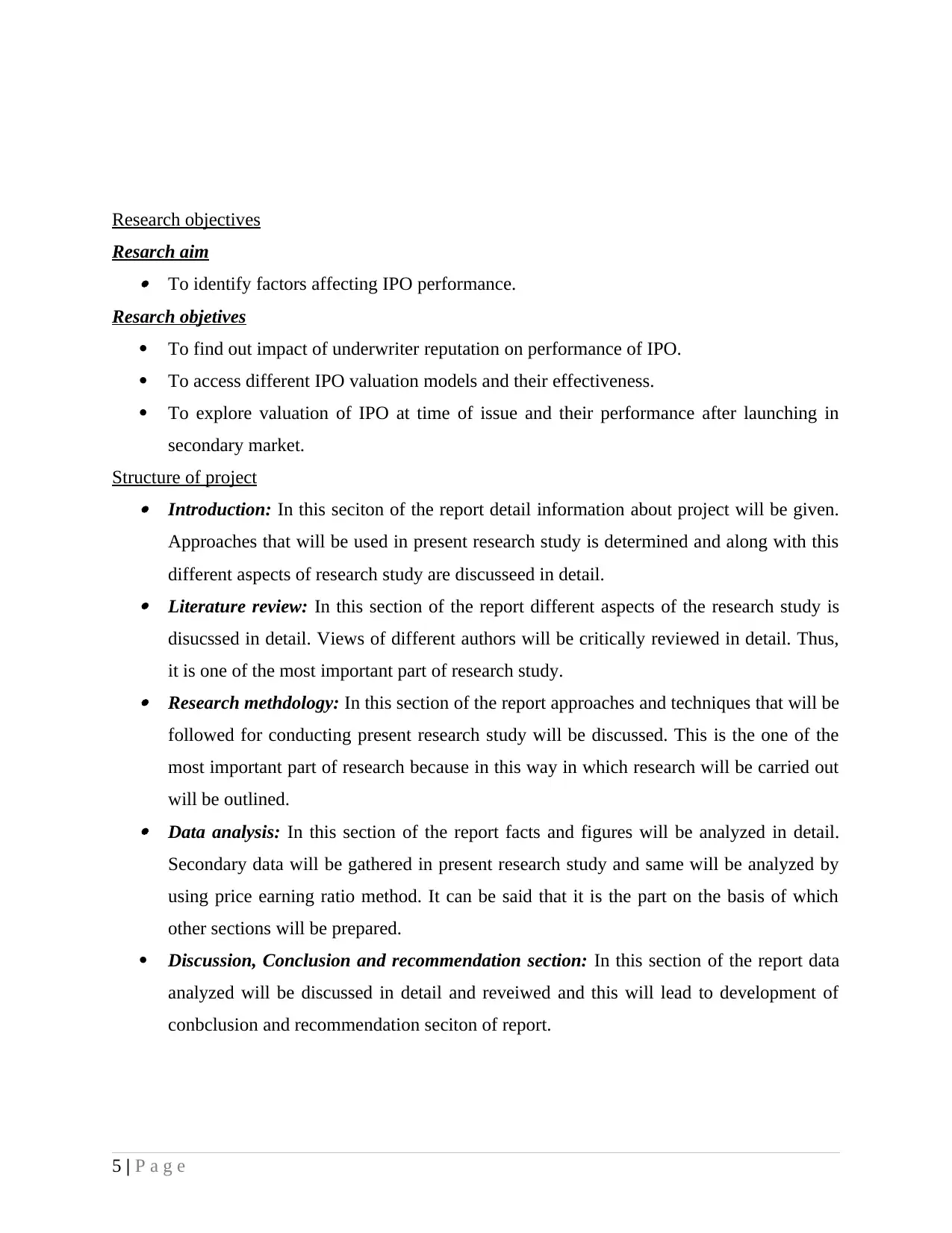
Research objectives
Resarch aim To identify factors affecting IPO performance.
Resarch objetives
To find out impact of underwriter reputation on performance of IPO.
To access different IPO valuation models and their effectiveness.
To explore valuation of IPO at time of issue and their performance after launching in
secondary market.
Structure of project Introduction: In this seciton of the report detail information about project will be given.
Approaches that will be used in present research study is determined and along with this
different aspects of research study are discusseed in detail. Literature review: In this section of the report different aspects of the research study is
disucssed in detail. Views of different authors will be critically reviewed in detail. Thus,
it is one of the most important part of research study. Research methdology: In this section of the report approaches and techniques that will be
followed for conducting present research study will be discussed. This is the one of the
most important part of research because in this way in which research will be carried out
will be outlined. Data analysis: In this section of the report facts and figures will be analyzed in detail.
Secondary data will be gathered in present research study and same will be analyzed by
using price earning ratio method. It can be said that it is the part on the basis of which
other sections will be prepared.
Discussion, Conclusion and recommendation section: In this section of the report data
analyzed will be discussed in detail and reveiwed and this will lead to development of
conbclusion and recommendation seciton of report.
5 | P a g e
Resarch aim To identify factors affecting IPO performance.
Resarch objetives
To find out impact of underwriter reputation on performance of IPO.
To access different IPO valuation models and their effectiveness.
To explore valuation of IPO at time of issue and their performance after launching in
secondary market.
Structure of project Introduction: In this seciton of the report detail information about project will be given.
Approaches that will be used in present research study is determined and along with this
different aspects of research study are discusseed in detail. Literature review: In this section of the report different aspects of the research study is
disucssed in detail. Views of different authors will be critically reviewed in detail. Thus,
it is one of the most important part of research study. Research methdology: In this section of the report approaches and techniques that will be
followed for conducting present research study will be discussed. This is the one of the
most important part of research because in this way in which research will be carried out
will be outlined. Data analysis: In this section of the report facts and figures will be analyzed in detail.
Secondary data will be gathered in present research study and same will be analyzed by
using price earning ratio method. It can be said that it is the part on the basis of which
other sections will be prepared.
Discussion, Conclusion and recommendation section: In this section of the report data
analyzed will be discussed in detail and reveiwed and this will lead to development of
conbclusion and recommendation seciton of report.
5 | P a g e
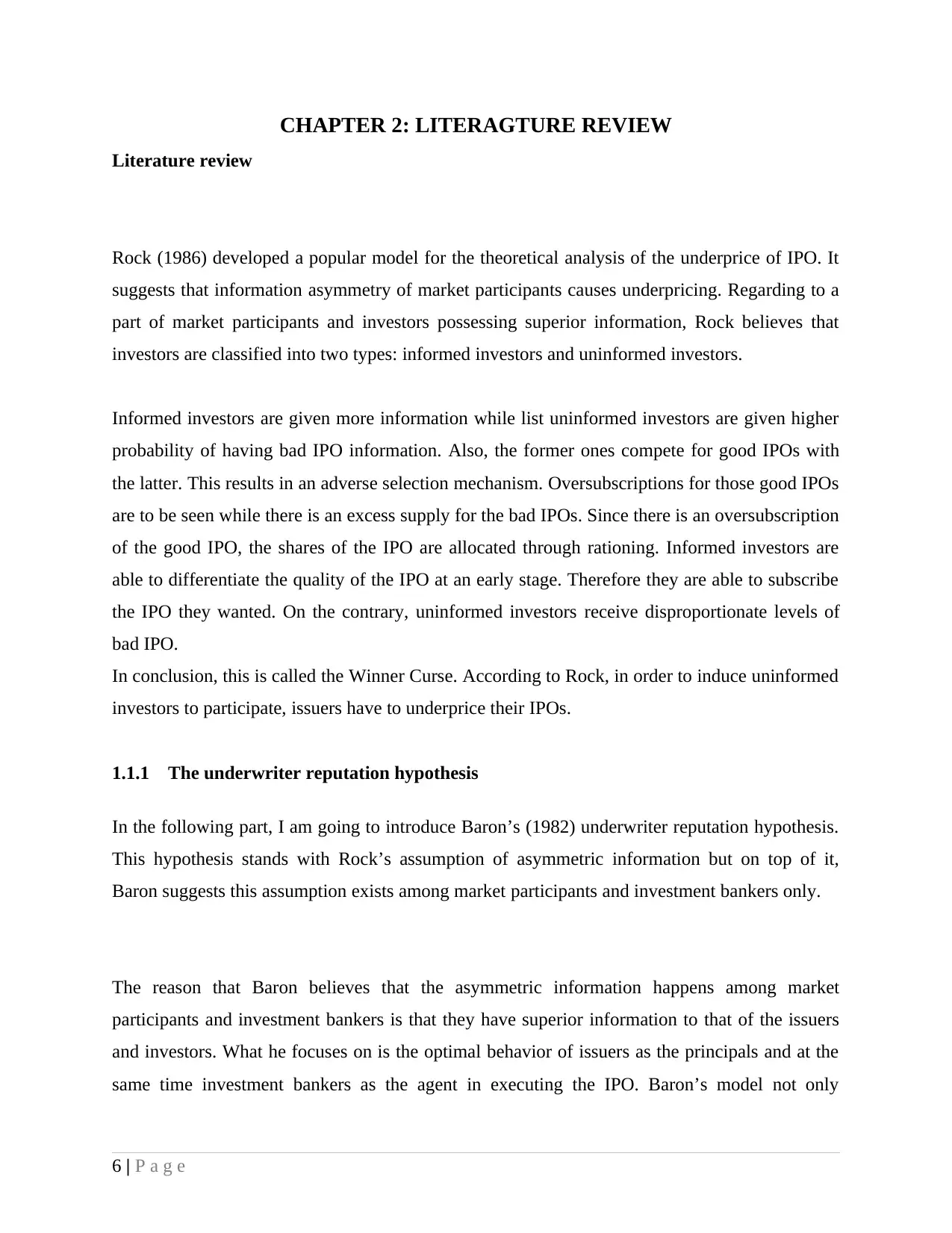
CHAPTER 2: LITERAGTURE REVIEW
Literature review
Rock (1986) developed a popular model for the theoretical analysis of the underprice of IPO. It
suggests that information asymmetry of market participants causes underpricing. Regarding to a
part of market participants and investors possessing superior information, Rock believes that
investors are classified into two types: informed investors and uninformed investors.
Informed investors are given more information while list uninformed investors are given higher
probability of having bad IPO information. Also, the former ones compete for good IPOs with
the latter. This results in an adverse selection mechanism. Oversubscriptions for those good IPOs
are to be seen while there is an excess supply for the bad IPOs. Since there is an oversubscription
of the good IPO, the shares of the IPO are allocated through rationing. Informed investors are
able to differentiate the quality of the IPO at an early stage. Therefore they are able to subscribe
the IPO they wanted. On the contrary, uninformed investors receive disproportionate levels of
bad IPO.
In conclusion, this is called the Winner Curse. According to Rock, in order to induce uninformed
investors to participate, issuers have to underprice their IPOs.
1.1.1 The underwriter reputation hypothesis
In the following part, I am going to introduce Baron’s (1982) underwriter reputation hypothesis.
This hypothesis stands with Rock’s assumption of asymmetric information but on top of it,
Baron suggests this assumption exists among market participants and investment bankers only.
The reason that Baron believes that the asymmetric information happens among market
participants and investment bankers is that they have superior information to that of the issuers
and investors. What he focuses on is the optimal behavior of issuers as the principals and at the
same time investment bankers as the agent in executing the IPO. Baron’s model not only
6 | P a g e
Literature review
Rock (1986) developed a popular model for the theoretical analysis of the underprice of IPO. It
suggests that information asymmetry of market participants causes underpricing. Regarding to a
part of market participants and investors possessing superior information, Rock believes that
investors are classified into two types: informed investors and uninformed investors.
Informed investors are given more information while list uninformed investors are given higher
probability of having bad IPO information. Also, the former ones compete for good IPOs with
the latter. This results in an adverse selection mechanism. Oversubscriptions for those good IPOs
are to be seen while there is an excess supply for the bad IPOs. Since there is an oversubscription
of the good IPO, the shares of the IPO are allocated through rationing. Informed investors are
able to differentiate the quality of the IPO at an early stage. Therefore they are able to subscribe
the IPO they wanted. On the contrary, uninformed investors receive disproportionate levels of
bad IPO.
In conclusion, this is called the Winner Curse. According to Rock, in order to induce uninformed
investors to participate, issuers have to underprice their IPOs.
1.1.1 The underwriter reputation hypothesis
In the following part, I am going to introduce Baron’s (1982) underwriter reputation hypothesis.
This hypothesis stands with Rock’s assumption of asymmetric information but on top of it,
Baron suggests this assumption exists among market participants and investment bankers only.
The reason that Baron believes that the asymmetric information happens among market
participants and investment bankers is that they have superior information to that of the issuers
and investors. What he focuses on is the optimal behavior of issuers as the principals and at the
same time investment bankers as the agent in executing the IPO. Baron’s model not only
6 | P a g e
⊘ This is a preview!⊘
Do you want full access?
Subscribe today to unlock all pages.

Trusted by 1+ million students worldwide
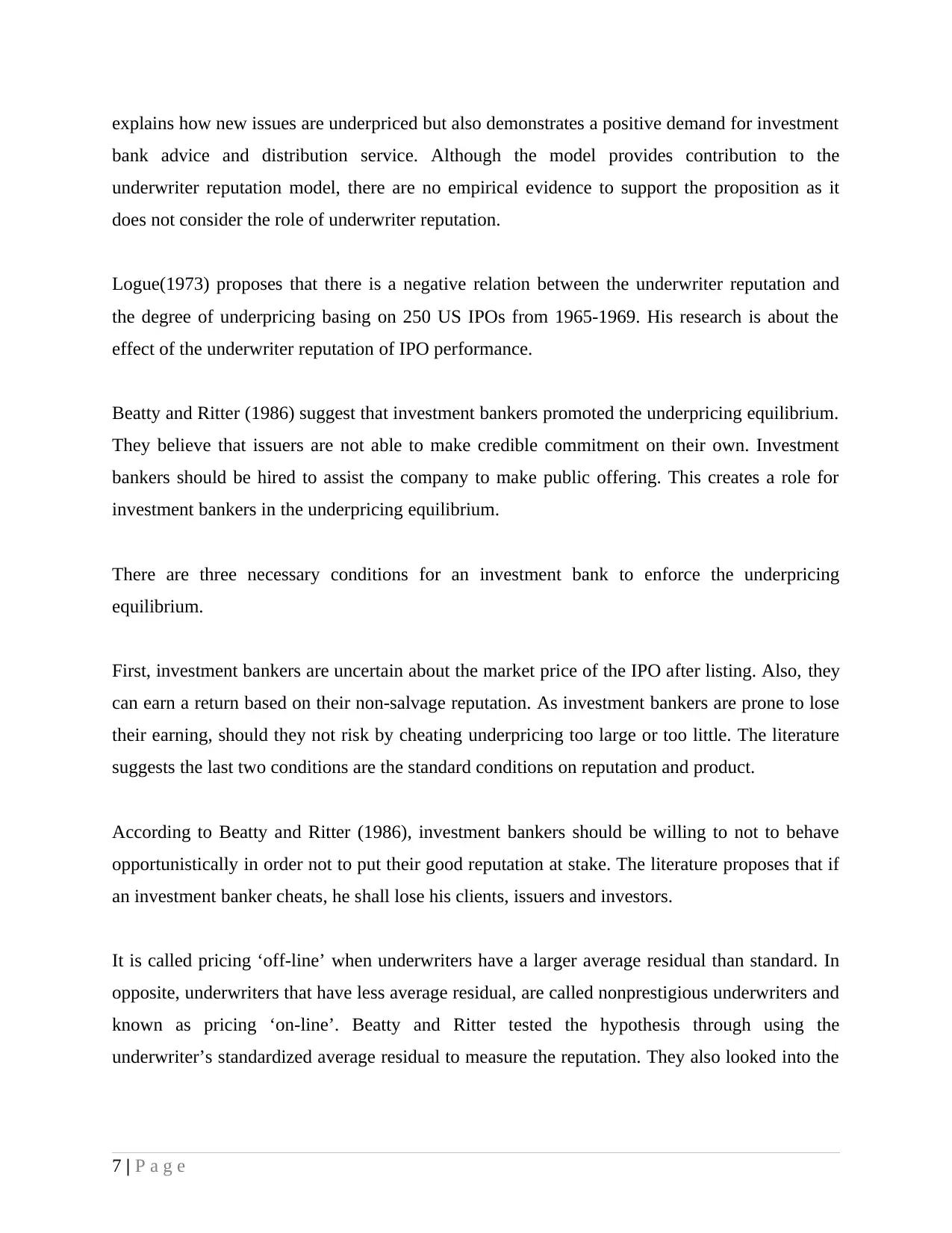
explains how new issues are underpriced but also demonstrates a positive demand for investment
bank advice and distribution service. Although the model provides contribution to the
underwriter reputation model, there are no empirical evidence to support the proposition as it
does not consider the role of underwriter reputation.
Logue(1973) proposes that there is a negative relation between the underwriter reputation and
the degree of underpricing basing on 250 US IPOs from 1965-1969. His research is about the
effect of the underwriter reputation of IPO performance.
Beatty and Ritter (1986) suggest that investment bankers promoted the underpricing equilibrium.
They believe that issuers are not able to make credible commitment on their own. Investment
bankers should be hired to assist the company to make public offering. This creates a role for
investment bankers in the underpricing equilibrium.
There are three necessary conditions for an investment bank to enforce the underpricing
equilibrium.
First, investment bankers are uncertain about the market price of the IPO after listing. Also, they
can earn a return based on their non-salvage reputation. As investment bankers are prone to lose
their earning, should they not risk by cheating underpricing too large or too little. The literature
suggests the last two conditions are the standard conditions on reputation and product.
According to Beatty and Ritter (1986), investment bankers should be willing to not to behave
opportunistically in order not to put their good reputation at stake. The literature proposes that if
an investment banker cheats, he shall lose his clients, issuers and investors.
It is called pricing ‘off-line’ when underwriters have a larger average residual than standard. In
opposite, underwriters that have less average residual, are called nonprestigious underwriters and
known as pricing ‘on-line’. Beatty and Ritter tested the hypothesis through using the
underwriter’s standardized average residual to measure the reputation. They also looked into the
7 | P a g e
bank advice and distribution service. Although the model provides contribution to the
underwriter reputation model, there are no empirical evidence to support the proposition as it
does not consider the role of underwriter reputation.
Logue(1973) proposes that there is a negative relation between the underwriter reputation and
the degree of underpricing basing on 250 US IPOs from 1965-1969. His research is about the
effect of the underwriter reputation of IPO performance.
Beatty and Ritter (1986) suggest that investment bankers promoted the underpricing equilibrium.
They believe that issuers are not able to make credible commitment on their own. Investment
bankers should be hired to assist the company to make public offering. This creates a role for
investment bankers in the underpricing equilibrium.
There are three necessary conditions for an investment bank to enforce the underpricing
equilibrium.
First, investment bankers are uncertain about the market price of the IPO after listing. Also, they
can earn a return based on their non-salvage reputation. As investment bankers are prone to lose
their earning, should they not risk by cheating underpricing too large or too little. The literature
suggests the last two conditions are the standard conditions on reputation and product.
According to Beatty and Ritter (1986), investment bankers should be willing to not to behave
opportunistically in order not to put their good reputation at stake. The literature proposes that if
an investment banker cheats, he shall lose his clients, issuers and investors.
It is called pricing ‘off-line’ when underwriters have a larger average residual than standard. In
opposite, underwriters that have less average residual, are called nonprestigious underwriters and
known as pricing ‘on-line’. Beatty and Ritter tested the hypothesis through using the
underwriter’s standardized average residual to measure the reputation. They also looked into the
7 | P a g e
Paraphrase This Document
Need a fresh take? Get an instant paraphrase of this document with our AI Paraphraser
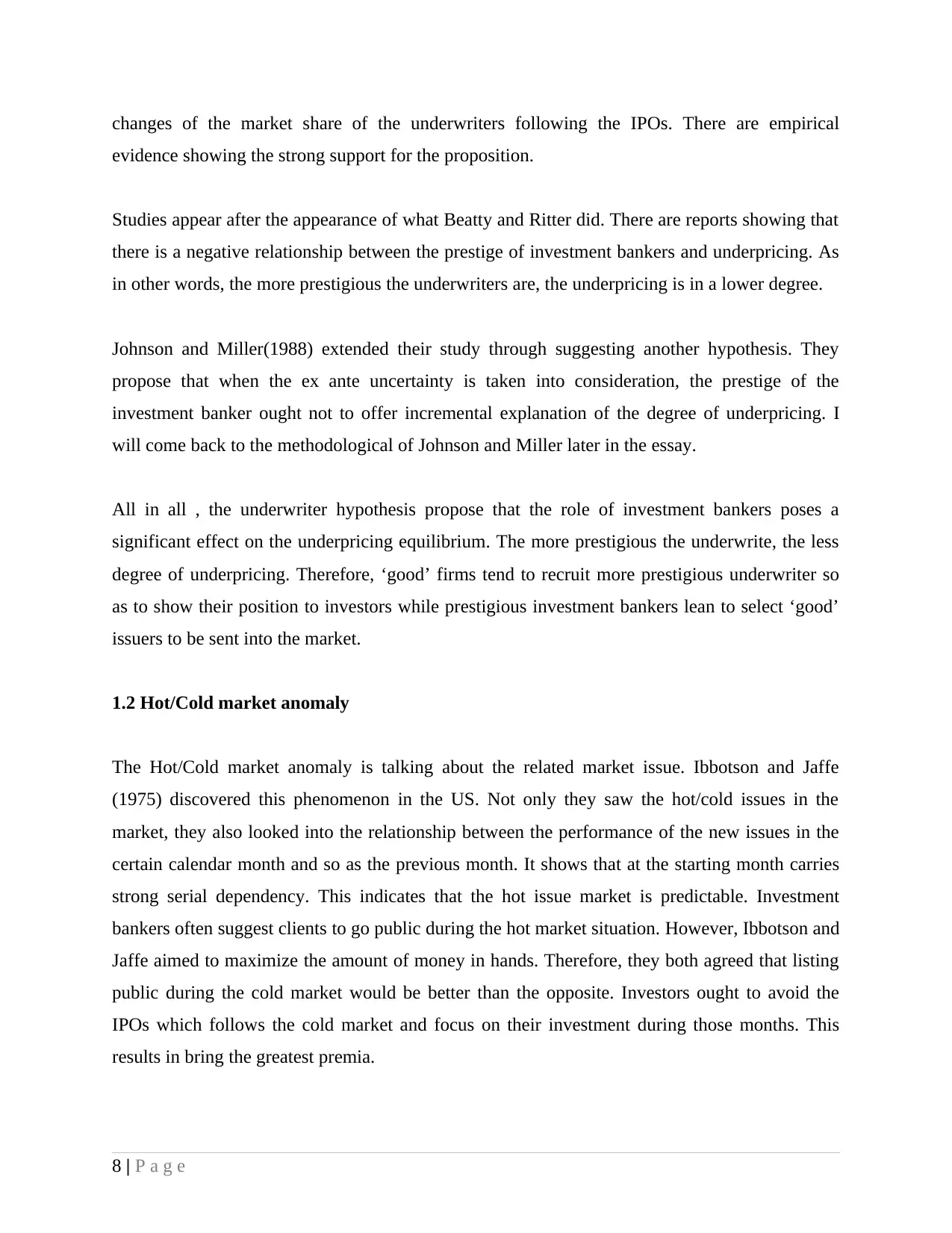
changes of the market share of the underwriters following the IPOs. There are empirical
evidence showing the strong support for the proposition.
Studies appear after the appearance of what Beatty and Ritter did. There are reports showing that
there is a negative relationship between the prestige of investment bankers and underpricing. As
in other words, the more prestigious the underwriters are, the underpricing is in a lower degree.
Johnson and Miller(1988) extended their study through suggesting another hypothesis. They
propose that when the ex ante uncertainty is taken into consideration, the prestige of the
investment banker ought not to offer incremental explanation of the degree of underpricing. I
will come back to the methodological of Johnson and Miller later in the essay.
All in all , the underwriter hypothesis propose that the role of investment bankers poses a
significant effect on the underpricing equilibrium. The more prestigious the underwrite, the less
degree of underpricing. Therefore, ‘good’ firms tend to recruit more prestigious underwriter so
as to show their position to investors while prestigious investment bankers lean to select ‘good’
issuers to be sent into the market.
1.2 Hot/Cold market anomaly
The Hot/Cold market anomaly is talking about the related market issue. Ibbotson and Jaffe
(1975) discovered this phenomenon in the US. Not only they saw the hot/cold issues in the
market, they also looked into the relationship between the performance of the new issues in the
certain calendar month and so as the previous month. It shows that at the starting month carries
strong serial dependency. This indicates that the hot issue market is predictable. Investment
bankers often suggest clients to go public during the hot market situation. However, Ibbotson and
Jaffe aimed to maximize the amount of money in hands. Therefore, they both agreed that listing
public during the cold market would be better than the opposite. Investors ought to avoid the
IPOs which follows the cold market and focus on their investment during those months. This
results in bring the greatest premia.
8 | P a g e
evidence showing the strong support for the proposition.
Studies appear after the appearance of what Beatty and Ritter did. There are reports showing that
there is a negative relationship between the prestige of investment bankers and underpricing. As
in other words, the more prestigious the underwriters are, the underpricing is in a lower degree.
Johnson and Miller(1988) extended their study through suggesting another hypothesis. They
propose that when the ex ante uncertainty is taken into consideration, the prestige of the
investment banker ought not to offer incremental explanation of the degree of underpricing. I
will come back to the methodological of Johnson and Miller later in the essay.
All in all , the underwriter hypothesis propose that the role of investment bankers poses a
significant effect on the underpricing equilibrium. The more prestigious the underwrite, the less
degree of underpricing. Therefore, ‘good’ firms tend to recruit more prestigious underwriter so
as to show their position to investors while prestigious investment bankers lean to select ‘good’
issuers to be sent into the market.
1.2 Hot/Cold market anomaly
The Hot/Cold market anomaly is talking about the related market issue. Ibbotson and Jaffe
(1975) discovered this phenomenon in the US. Not only they saw the hot/cold issues in the
market, they also looked into the relationship between the performance of the new issues in the
certain calendar month and so as the previous month. It shows that at the starting month carries
strong serial dependency. This indicates that the hot issue market is predictable. Investment
bankers often suggest clients to go public during the hot market situation. However, Ibbotson and
Jaffe aimed to maximize the amount of money in hands. Therefore, they both agreed that listing
public during the cold market would be better than the opposite. Investors ought to avoid the
IPOs which follows the cold market and focus on their investment during those months. This
results in bring the greatest premia.
8 | P a g e
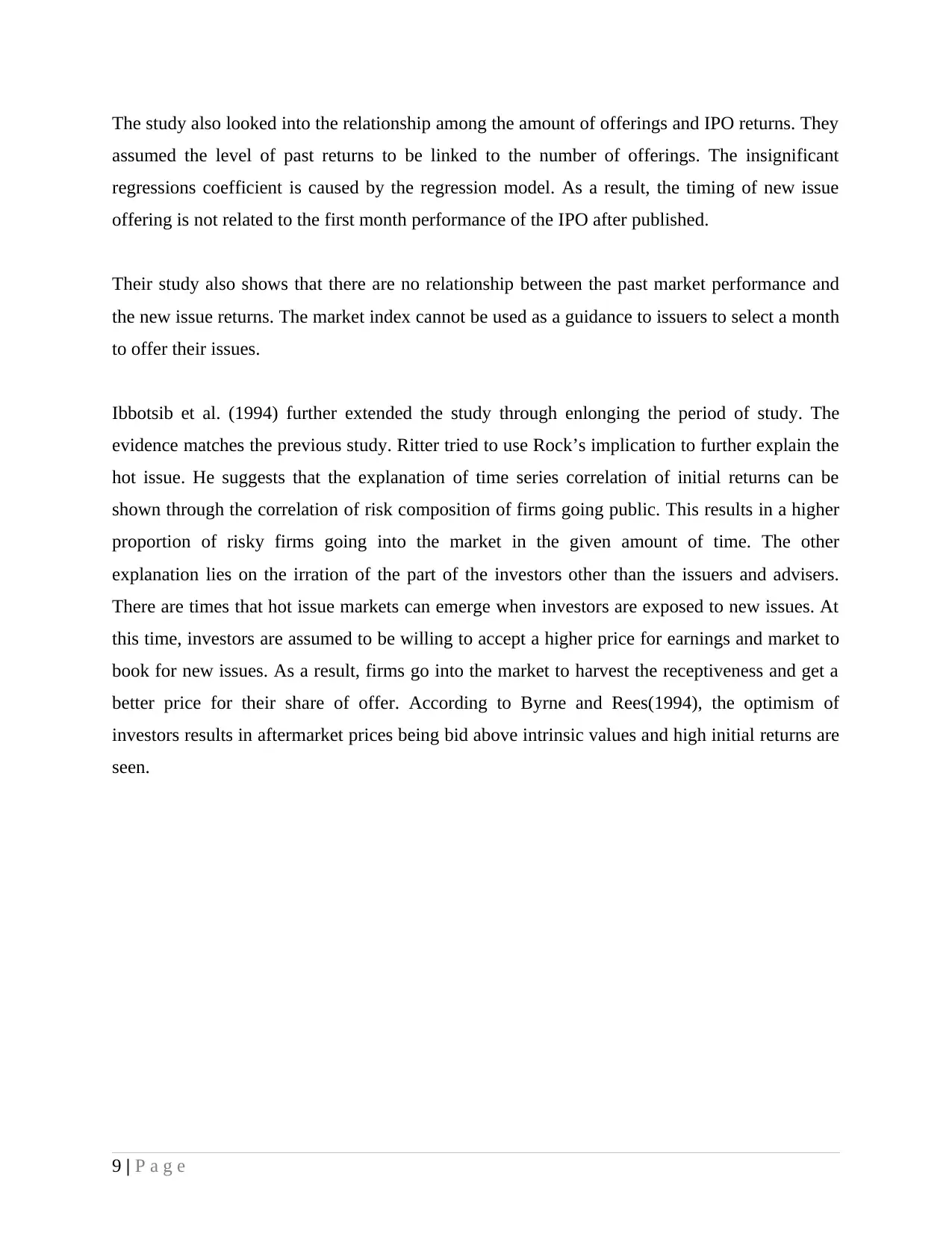
The study also looked into the relationship among the amount of offerings and IPO returns. They
assumed the level of past returns to be linked to the number of offerings. The insignificant
regressions coefficient is caused by the regression model. As a result, the timing of new issue
offering is not related to the first month performance of the IPO after published.
Their study also shows that there are no relationship between the past market performance and
the new issue returns. The market index cannot be used as a guidance to issuers to select a month
to offer their issues.
Ibbotsib et al. (1994) further extended the study through enlonging the period of study. The
evidence matches the previous study. Ritter tried to use Rock’s implication to further explain the
hot issue. He suggests that the explanation of time series correlation of initial returns can be
shown through the correlation of risk composition of firms going public. This results in a higher
proportion of risky firms going into the market in the given amount of time. The other
explanation lies on the irration of the part of the investors other than the issuers and advisers.
There are times that hot issue markets can emerge when investors are exposed to new issues. At
this time, investors are assumed to be willing to accept a higher price for earnings and market to
book for new issues. As a result, firms go into the market to harvest the receptiveness and get a
better price for their share of offer. According to Byrne and Rees(1994), the optimism of
investors results in aftermarket prices being bid above intrinsic values and high initial returns are
seen.
9 | P a g e
assumed the level of past returns to be linked to the number of offerings. The insignificant
regressions coefficient is caused by the regression model. As a result, the timing of new issue
offering is not related to the first month performance of the IPO after published.
Their study also shows that there are no relationship between the past market performance and
the new issue returns. The market index cannot be used as a guidance to issuers to select a month
to offer their issues.
Ibbotsib et al. (1994) further extended the study through enlonging the period of study. The
evidence matches the previous study. Ritter tried to use Rock’s implication to further explain the
hot issue. He suggests that the explanation of time series correlation of initial returns can be
shown through the correlation of risk composition of firms going public. This results in a higher
proportion of risky firms going into the market in the given amount of time. The other
explanation lies on the irration of the part of the investors other than the issuers and advisers.
There are times that hot issue markets can emerge when investors are exposed to new issues. At
this time, investors are assumed to be willing to accept a higher price for earnings and market to
book for new issues. As a result, firms go into the market to harvest the receptiveness and get a
better price for their share of offer. According to Byrne and Rees(1994), the optimism of
investors results in aftermarket prices being bid above intrinsic values and high initial returns are
seen.
9 | P a g e
⊘ This is a preview!⊘
Do you want full access?
Subscribe today to unlock all pages.

Trusted by 1+ million students worldwide
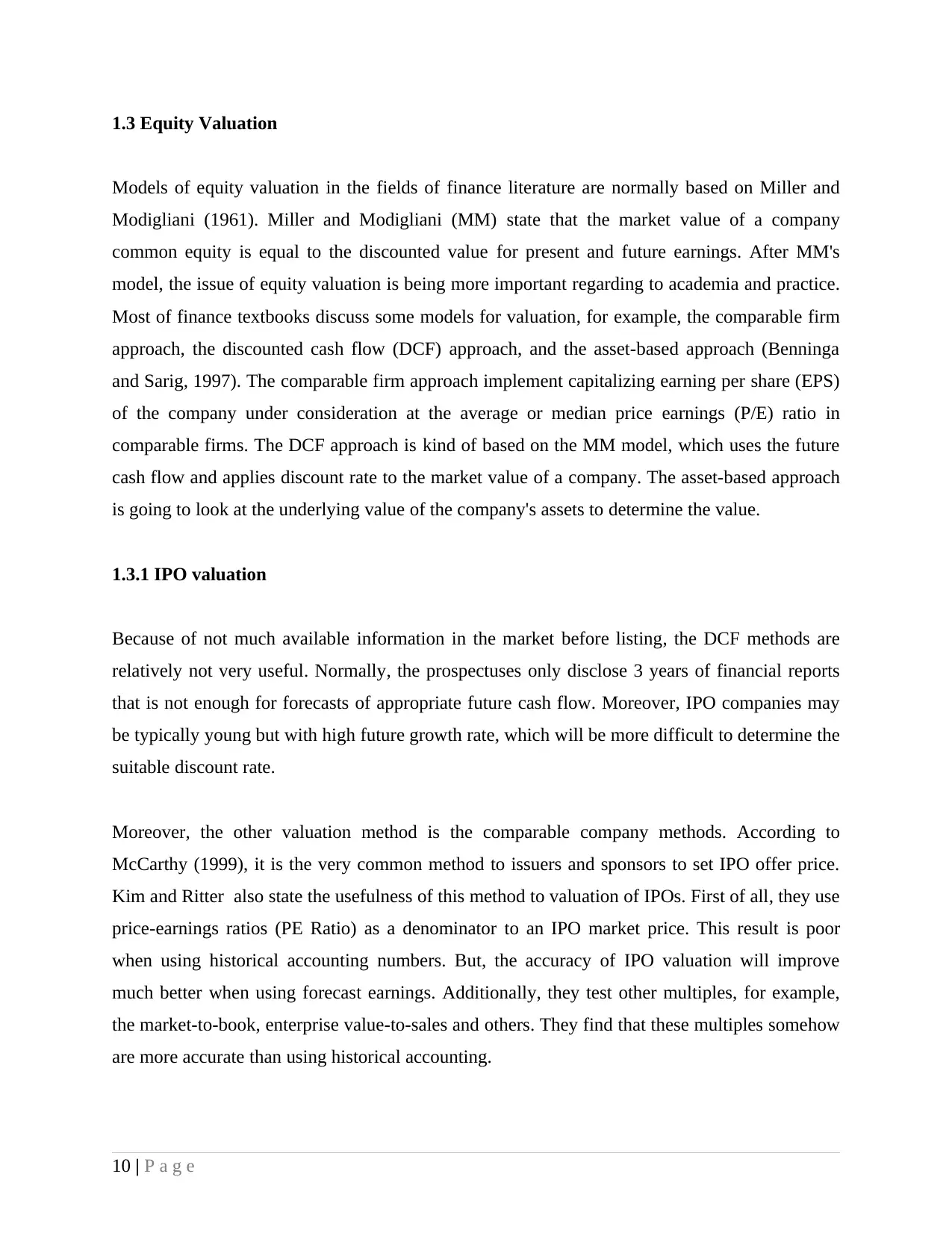
1.3 Equity Valuation
Models of equity valuation in the fields of finance literature are normally based on Miller and
Modigliani (1961). Miller and Modigliani (MM) state that the market value of a company
common equity is equal to the discounted value for present and future earnings. After MM's
model, the issue of equity valuation is being more important regarding to academia and practice.
Most of finance textbooks discuss some models for valuation, for example, the comparable firm
approach, the discounted cash flow (DCF) approach, and the asset-based approach (Benninga
and Sarig, 1997). The comparable firm approach implement capitalizing earning per share (EPS)
of the company under consideration at the average or median price earnings (P/E) ratio in
comparable firms. The DCF approach is kind of based on the MM model, which uses the future
cash flow and applies discount rate to the market value of a company. The asset-based approach
is going to look at the underlying value of the company's assets to determine the value.
1.3.1 IPO valuation
Because of not much available information in the market before listing, the DCF methods are
relatively not very useful. Normally, the prospectuses only disclose 3 years of financial reports
that is not enough for forecasts of appropriate future cash flow. Moreover, IPO companies may
be typically young but with high future growth rate, which will be more difficult to determine the
suitable discount rate.
Moreover, the other valuation method is the comparable company methods. According to
McCarthy (1999), it is the very common method to issuers and sponsors to set IPO offer price.
Kim and Ritter also state the usefulness of this method to valuation of IPOs. First of all, they use
price-earnings ratios (PE Ratio) as a denominator to an IPO market price. This result is poor
when using historical accounting numbers. But, the accuracy of IPO valuation will improve
much better when using forecast earnings. Additionally, they test other multiples, for example,
the market-to-book, enterprise value-to-sales and others. They find that these multiples somehow
are more accurate than using historical accounting.
10 | P a g e
Models of equity valuation in the fields of finance literature are normally based on Miller and
Modigliani (1961). Miller and Modigliani (MM) state that the market value of a company
common equity is equal to the discounted value for present and future earnings. After MM's
model, the issue of equity valuation is being more important regarding to academia and practice.
Most of finance textbooks discuss some models for valuation, for example, the comparable firm
approach, the discounted cash flow (DCF) approach, and the asset-based approach (Benninga
and Sarig, 1997). The comparable firm approach implement capitalizing earning per share (EPS)
of the company under consideration at the average or median price earnings (P/E) ratio in
comparable firms. The DCF approach is kind of based on the MM model, which uses the future
cash flow and applies discount rate to the market value of a company. The asset-based approach
is going to look at the underlying value of the company's assets to determine the value.
1.3.1 IPO valuation
Because of not much available information in the market before listing, the DCF methods are
relatively not very useful. Normally, the prospectuses only disclose 3 years of financial reports
that is not enough for forecasts of appropriate future cash flow. Moreover, IPO companies may
be typically young but with high future growth rate, which will be more difficult to determine the
suitable discount rate.
Moreover, the other valuation method is the comparable company methods. According to
McCarthy (1999), it is the very common method to issuers and sponsors to set IPO offer price.
Kim and Ritter also state the usefulness of this method to valuation of IPOs. First of all, they use
price-earnings ratios (PE Ratio) as a denominator to an IPO market price. This result is poor
when using historical accounting numbers. But, the accuracy of IPO valuation will improve
much better when using forecast earnings. Additionally, they test other multiples, for example,
the market-to-book, enterprise value-to-sales and others. They find that these multiples somehow
are more accurate than using historical accounting.
10 | P a g e
Paraphrase This Document
Need a fresh take? Get an instant paraphrase of this document with our AI Paraphraser
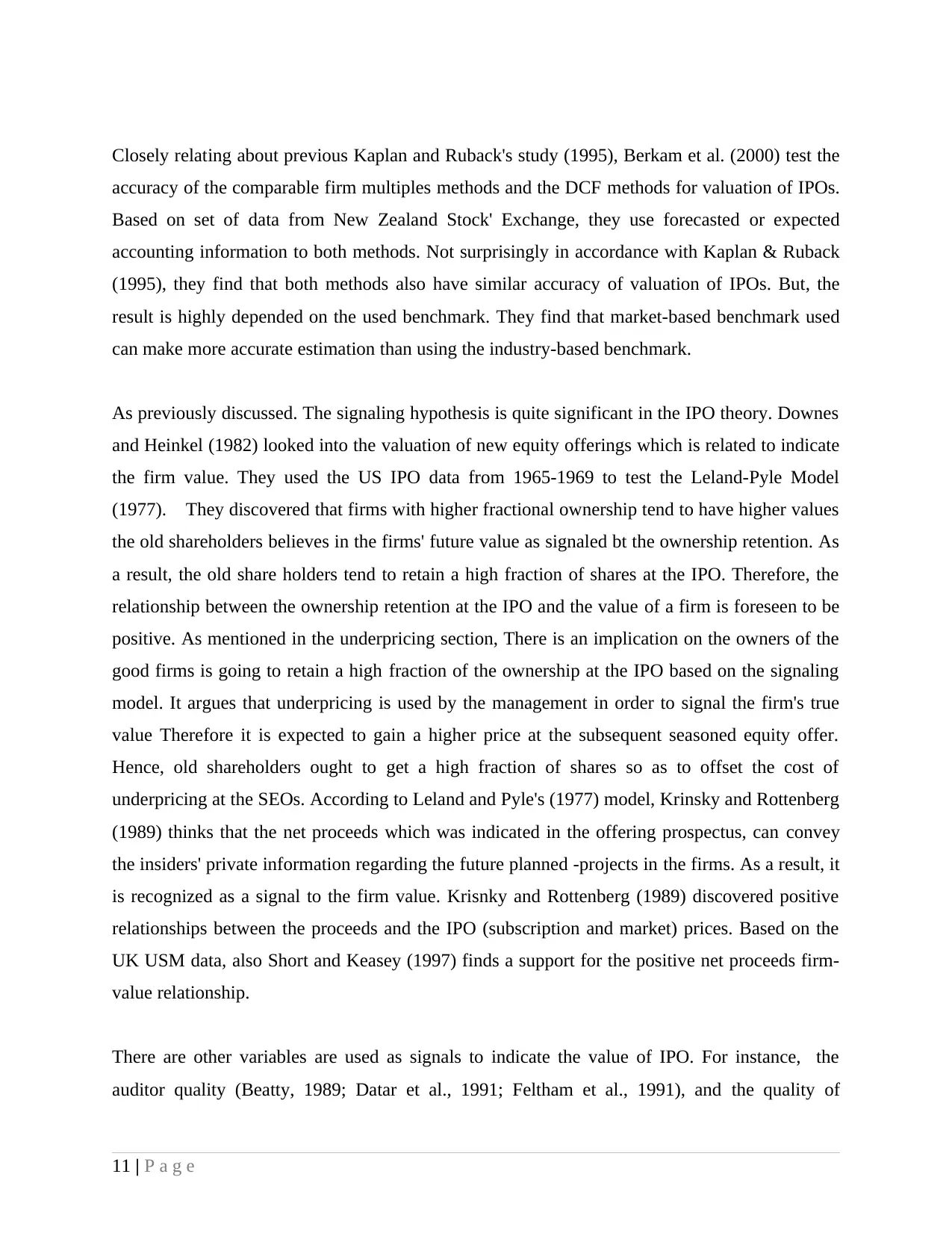
Closely relating about previous Kaplan and Ruback's study (1995), Berkam et al. (2000) test the
accuracy of the comparable firm multiples methods and the DCF methods for valuation of IPOs.
Based on set of data from New Zealand Stock' Exchange, they use forecasted or expected
accounting information to both methods. Not surprisingly in accordance with Kaplan & Ruback
(1995), they find that both methods also have similar accuracy of valuation of IPOs. But, the
result is highly depended on the used benchmark. They find that market-based benchmark used
can make more accurate estimation than using the industry-based benchmark.
As previously discussed. The signaling hypothesis is quite significant in the IPO theory. Downes
and Heinkel (1982) looked into the valuation of new equity offerings which is related to indicate
the firm value. They used the US IPO data from 1965-1969 to test the Leland-Pyle Model
(1977). They discovered that firms with higher fractional ownership tend to have higher values
the old shareholders believes in the firms' future value as signaled bt the ownership retention. As
a result, the old share holders tend to retain a high fraction of shares at the IPO. Therefore, the
relationship between the ownership retention at the IPO and the value of a firm is foreseen to be
positive. As mentioned in the underpricing section, There is an implication on the owners of the
good firms is going to retain a high fraction of the ownership at the IPO based on the signaling
model. It argues that underpricing is used by the management in order to signal the firm's true
value Therefore it is expected to gain a higher price at the subsequent seasoned equity offer.
Hence, old shareholders ought to get a high fraction of shares so as to offset the cost of
underpricing at the SEOs. According to Leland and Pyle's (1977) model, Krinsky and Rottenberg
(1989) thinks that the net proceeds which was indicated in the offering prospectus, can convey
the insiders' private information regarding the future planned -projects in the firms. As a result, it
is recognized as a signal to the firm value. Krisnky and Rottenberg (1989) discovered positive
relationships between the proceeds and the IPO (subscription and market) prices. Based on the
UK USM data, also Short and Keasey (1997) finds a support for the positive net proceeds firm-
value relationship.
There are other variables are used as signals to indicate the value of IPO. For instance, the
auditor quality (Beatty, 1989; Datar et al., 1991; Feltham et al., 1991), and the quality of
11 | P a g e
accuracy of the comparable firm multiples methods and the DCF methods for valuation of IPOs.
Based on set of data from New Zealand Stock' Exchange, they use forecasted or expected
accounting information to both methods. Not surprisingly in accordance with Kaplan & Ruback
(1995), they find that both methods also have similar accuracy of valuation of IPOs. But, the
result is highly depended on the used benchmark. They find that market-based benchmark used
can make more accurate estimation than using the industry-based benchmark.
As previously discussed. The signaling hypothesis is quite significant in the IPO theory. Downes
and Heinkel (1982) looked into the valuation of new equity offerings which is related to indicate
the firm value. They used the US IPO data from 1965-1969 to test the Leland-Pyle Model
(1977). They discovered that firms with higher fractional ownership tend to have higher values
the old shareholders believes in the firms' future value as signaled bt the ownership retention. As
a result, the old share holders tend to retain a high fraction of shares at the IPO. Therefore, the
relationship between the ownership retention at the IPO and the value of a firm is foreseen to be
positive. As mentioned in the underpricing section, There is an implication on the owners of the
good firms is going to retain a high fraction of the ownership at the IPO based on the signaling
model. It argues that underpricing is used by the management in order to signal the firm's true
value Therefore it is expected to gain a higher price at the subsequent seasoned equity offer.
Hence, old shareholders ought to get a high fraction of shares so as to offset the cost of
underpricing at the SEOs. According to Leland and Pyle's (1977) model, Krinsky and Rottenberg
(1989) thinks that the net proceeds which was indicated in the offering prospectus, can convey
the insiders' private information regarding the future planned -projects in the firms. As a result, it
is recognized as a signal to the firm value. Krisnky and Rottenberg (1989) discovered positive
relationships between the proceeds and the IPO (subscription and market) prices. Based on the
UK USM data, also Short and Keasey (1997) finds a support for the positive net proceeds firm-
value relationship.
There are other variables are used as signals to indicate the value of IPO. For instance, the
auditor quality (Beatty, 1989; Datar et al., 1991; Feltham et al., 1991), and the quality of
11 | P a g e
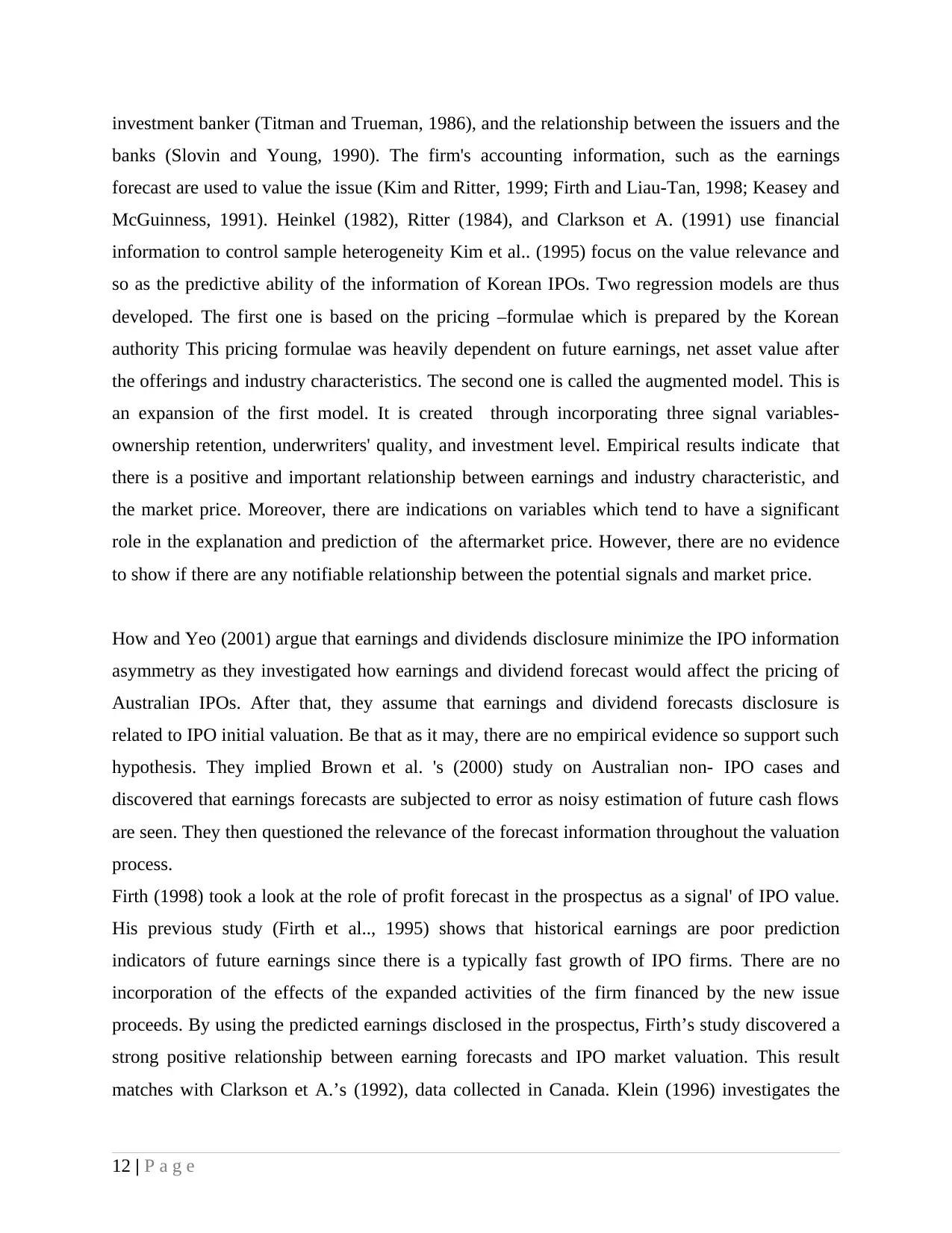
investment banker (Titman and Trueman, 1986), and the relationship between the issuers and the
banks (Slovin and Young, 1990). The firm's accounting information, such as the earnings
forecast are used to value the issue (Kim and Ritter, 1999; Firth and Liau-Tan, 1998; Keasey and
McGuinness, 1991). Heinkel (1982), Ritter (1984), and Clarkson et A. (1991) use financial
information to control sample heterogeneity Kim et al.. (1995) focus on the value relevance and
so as the predictive ability of the information of Korean IPOs. Two regression models are thus
developed. The first one is based on the pricing –formulae which is prepared by the Korean
authority This pricing formulae was heavily dependent on future earnings, net asset value after
the offerings and industry characteristics. The second one is called the augmented model. This is
an expansion of the first model. It is created through incorporating three signal variables-
ownership retention, underwriters' quality, and investment level. Empirical results indicate that
there is a positive and important relationship between earnings and industry characteristic, and
the market price. Moreover, there are indications on variables which tend to have a significant
role in the explanation and prediction of the aftermarket price. However, there are no evidence
to show if there are any notifiable relationship between the potential signals and market price.
How and Yeo (2001) argue that earnings and dividends disclosure minimize the IPO information
asymmetry as they investigated how earnings and dividend forecast would affect the pricing of
Australian IPOs. After that, they assume that earnings and dividend forecasts disclosure is
related to IPO initial valuation. Be that as it may, there are no empirical evidence so support such
hypothesis. They implied Brown et al. 's (2000) study on Australian non- IPO cases and
discovered that earnings forecasts are subjected to error as noisy estimation of future cash flows
are seen. They then questioned the relevance of the forecast information throughout the valuation
process.
Firth (1998) took a look at the role of profit forecast in the prospectus as a signal' of IPO value.
His previous study (Firth et al.., 1995) shows that historical earnings are poor prediction
indicators of future earnings since there is a typically fast growth of IPO firms. There are no
incorporation of the effects of the expanded activities of the firm financed by the new issue
proceeds. By using the predicted earnings disclosed in the prospectus, Firth’s study discovered a
strong positive relationship between earning forecasts and IPO market valuation. This result
matches with Clarkson et A.’s (1992), data collected in Canada. Klein (1996) investigates the
12 | P a g e
banks (Slovin and Young, 1990). The firm's accounting information, such as the earnings
forecast are used to value the issue (Kim and Ritter, 1999; Firth and Liau-Tan, 1998; Keasey and
McGuinness, 1991). Heinkel (1982), Ritter (1984), and Clarkson et A. (1991) use financial
information to control sample heterogeneity Kim et al.. (1995) focus on the value relevance and
so as the predictive ability of the information of Korean IPOs. Two regression models are thus
developed. The first one is based on the pricing –formulae which is prepared by the Korean
authority This pricing formulae was heavily dependent on future earnings, net asset value after
the offerings and industry characteristics. The second one is called the augmented model. This is
an expansion of the first model. It is created through incorporating three signal variables-
ownership retention, underwriters' quality, and investment level. Empirical results indicate that
there is a positive and important relationship between earnings and industry characteristic, and
the market price. Moreover, there are indications on variables which tend to have a significant
role in the explanation and prediction of the aftermarket price. However, there are no evidence
to show if there are any notifiable relationship between the potential signals and market price.
How and Yeo (2001) argue that earnings and dividends disclosure minimize the IPO information
asymmetry as they investigated how earnings and dividend forecast would affect the pricing of
Australian IPOs. After that, they assume that earnings and dividend forecasts disclosure is
related to IPO initial valuation. Be that as it may, there are no empirical evidence so support such
hypothesis. They implied Brown et al. 's (2000) study on Australian non- IPO cases and
discovered that earnings forecasts are subjected to error as noisy estimation of future cash flows
are seen. They then questioned the relevance of the forecast information throughout the valuation
process.
Firth (1998) took a look at the role of profit forecast in the prospectus as a signal' of IPO value.
His previous study (Firth et al.., 1995) shows that historical earnings are poor prediction
indicators of future earnings since there is a typically fast growth of IPO firms. There are no
incorporation of the effects of the expanded activities of the firm financed by the new issue
proceeds. By using the predicted earnings disclosed in the prospectus, Firth’s study discovered a
strong positive relationship between earning forecasts and IPO market valuation. This result
matches with Clarkson et A.’s (1992), data collected in Canada. Klein (1996) investigates the
12 | P a g e
⊘ This is a preview!⊘
Do you want full access?
Subscribe today to unlock all pages.

Trusted by 1+ million students worldwide
1 out of 29
Related Documents
Your All-in-One AI-Powered Toolkit for Academic Success.
+13062052269
info@desklib.com
Available 24*7 on WhatsApp / Email
![[object Object]](/_next/static/media/star-bottom.7253800d.svg)
Unlock your academic potential
Copyright © 2020–2025 A2Z Services. All Rights Reserved. Developed and managed by ZUCOL.





